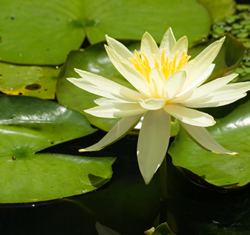
When creating a fish pond, you must use a pond
liner. There are several different types of pond liners that can
be used: concrete, fiberglass, rigid plastic and flexible plastic
liners. Each one has advantages and disadvantages. Understanding more
about the different types will help you decide which one is best for
your garden.
· Concrete pond liners will last a very long time, maybe even
as long as the house. If you know that you want a permanent garden
pond, then concrete is the way to go. One of the problems with concrete
pond liners is that they tend to leak toxins to the water. It requires
a lot of maintenance to remove the toxins and the chlorine from the
water, sometimes even several days. Most concrete pond liners have
been replaced by other liners like rigid and flexible plastic. Concrete
liners are also very expensive.
· Fiberglass pond liners have a lifespan of about 50 years.
They are easy to install; just set them in the ground, fill with water,
and add plants and animals. Fiberglass also expands for ice and does
not crack like some plastic liners do. Fiberglass liners have the
disadvantage of looking less natural and harder to disguise.
· Rigid plastic pond liners are the least expensive of all
four types of pond liners. They can look natural if you get a black
or dark green color and will tend to be more resistant to sharp roots
or rocks. The problem with rigid plastic is that they are very difficult
to install. It can be difficult to get just the right size of a hole
to lay the liner in and prevent leaks and drainage. The rigid container
also doesn’t do well resisting ice. It’s a good liner
for warmer climates.
· The last liner is a flexible pond liner. There are actually
4 types of these liners, but the best one is an EPDM (Ethylene Propylene
Diene Monomer) liner. This has several advantages over the other flexible
liners. It’s lifespan is about 20 years, it resists weathering
and cracking in the cold and heat, is non-toxic to the animals, and
is inexpensive. This liner is good in any climate and is easier to
install because of its flexibility.
When installing the pond liner, no matter which one you use, there
are some basic steps that should be taken before you install it. Decide
where you want to place the pond and outline the shape and size with
chalk or colored string. Start digging your hole at least 3 inches
outside of the line and it shouldn’t be deeper than 2 feet.
If it’s deeper than this, you might need to get a permit.
Fill the bottom of the whole with sand and salt to retard unwanted
growth and make the bottom more level. You then put your liner in
and fill with water. It sounds easy, but will take a little work to
get it just right. Perfecting the installation of your pond liner
now will prevent more maintenance and problems in the future.